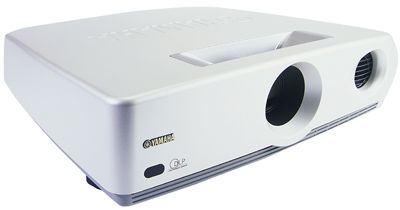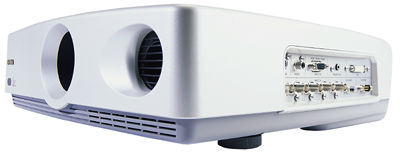Yamaha DPX-1 DLP video projector Page 2
A single test pattern (crosshatch) is stored in the projector to assist in setup, though a DVD such as Video Essentials will be far more useful. Setup and operation are performed by navigating onscreen menus. Both 4:3 and 16:9 screens are accommodated, with the usual selectable aspect ratios for each: Normal (4:3), Zoom (non-anamorphic letterbox), and Squeeze (anamorphic). For 16:9 there is also a Zoom Subtitle mode that raises the image by a user-adjustable amount to keep subtitles from dropping off the bottom of the screen. There are also several "Through" modes that display the image at its native resolution (using less than the full DMD panel) rather than scaling it up to fit the full available pixel array. And Auto modes for both screen shapes automatically select the appropriate aspect ratio (though the program material must be properly encoded for it to work properly).

Other important setup functions include six separate, user-configurable video memories and a complete set of video controls. These include a number of unusual options. In addition to the expected Contrast and Brightness controls, there is a separate Black Level adjustment. In most video displays, the terms "brightness" and "black level" are interchangeable. Here, however, Black Level affects the output only at the low end of the light-level range, Contrast affects the output at the high end, and Brightness affects the overall level. There may be advantages to having all three functions separately addressable, but I found I could get a very satisfactory image from using just Black Level and Contrast and leaving Brightness centered.
There are four user-selectable settings for color temperature. There are also color-temperature calibration controls—called White Balance here—which simultaneously adjust all four factory presets. Normally, such controls are available only on a separate, concealed service menu. Here they're available to the user, but unless you have the proper tools, I don't recommend fiddling with them. Still, you won't mess up anything by doing so, except possibly the picture quality and your seniority in the video tweakers club. It's easy enough to return to the factory settings.
Other features include adjustable setup level (0 or 7.5 IRE), a 3D Y/C comb filter for the video input, and a built-in scaler with 3:2 pulldown recognition. There's also a five-position Gamma control. Position C is intended to duplicate the response of a CRT, and that's where I left it throughout the tests.
One important factor with any projector is the life of the bulbs and their replacement cost. According to a Yamaha representative, the bulb in the DPX-1 should last about 2000 hours, but the company recommends replacement after 1000 hours. Beyond 1000 hours, bulb deterioration will affect picture quality. The current bulb-replacement cost is $600. To put that in perspective, when I researched the cost to replace the three tubes in a 7-inch CRT projector three years ago, it was about $2000, including labor (CRT replacement is not a do-it-yourself job). CRTs should last more than 1000 hours, but you presumably bought a front projector not just for a big picture, but for a good one as well. That means you might want to re-tube after 2000 hours or so—more expensive than replacing the bulb in the DPX-1 every 1000 hours.
Setup
Faced with having to position the projector at a height considerably different from optimum (a floor-mounted CRT was in the way and could not be moved), I had an immediate need for both the Digital Lens Shift and Keystone controls. The settings I used (a full –96 for Lens Shift, and –29 out of a range of –128 to +127 for Keystone) compensated completely for this non-optimum location. The Keystone control does introduce jagged edges on the built-in crosshatch pattern, but did not cause similar distortion on either normal program material or test patterns from the Video Essentials DVD. There was also enough depth of field in the lens to provide equally good focus at the top and bottom of the image with this setup.

All DLP projectors designed for home use have zoom lenses, which provides a degree of flexibility that CRTs lack. But before you buy any projector, verify that its "throw distance" is compatible with your room and screen size. You don't want to get a projector home only to find out that your room isn't long enough, or that the only usable throw distance puts the projector in your lap. Yamaha's very complete owner's manual provides useful tables for throw distance relative to screen size. The smart buyer will study them carefully before purchase.
Other than these few issues, setup involved placing the projector on a solid surface, lining it up with the screen, connecting the sources, zooming the image in or out to fit the screen, and focusing. It should take you all of about 15 minutes. Add another few minutes to run through the setup menus and make the appropriate settings, and you're ready to watch a movie.
Setting the video controls involves the same procedures required with any video display, with one exception. DLPs do not bloom, but at excessive Contrast settings you can clip the brightest whites. The visible effect of this is a lack of fine gradations at the top end of the brightness range; all the whites above a certain level look the same. (For recommendations on proper setting of the white level, see "Tweak Tips" in the Sèleco HT200D14 review in this issue.)
Reflections
The Yamaha DPX-1 excelled in believable color reproduction, excellent detail, and high light output. While its colors may have been a bit less rich than those from a CRT, you won't notice this without a direct comparison. Stuart Little was designed to look over-the-top, with overly full-bodied, almost cartoonish colors. The Yamaha captured its vivid art design while retaining believable—though intentionally oversaturated—flesh tones. Snatch is at the opposite end of the artistic spectrum. Its color palette is, by design, very muted, almost washed-out, and it looked just right on the Yamaha. So did everything else I watched, from Titanic to Proof of Life. Animation tends to be easy for most video displays to handle well, but knowing this I was still impressed by the way the colors in El Dorado popped off the screen.























































